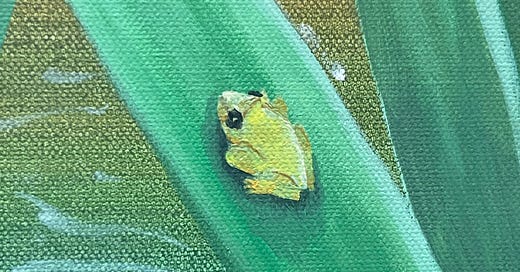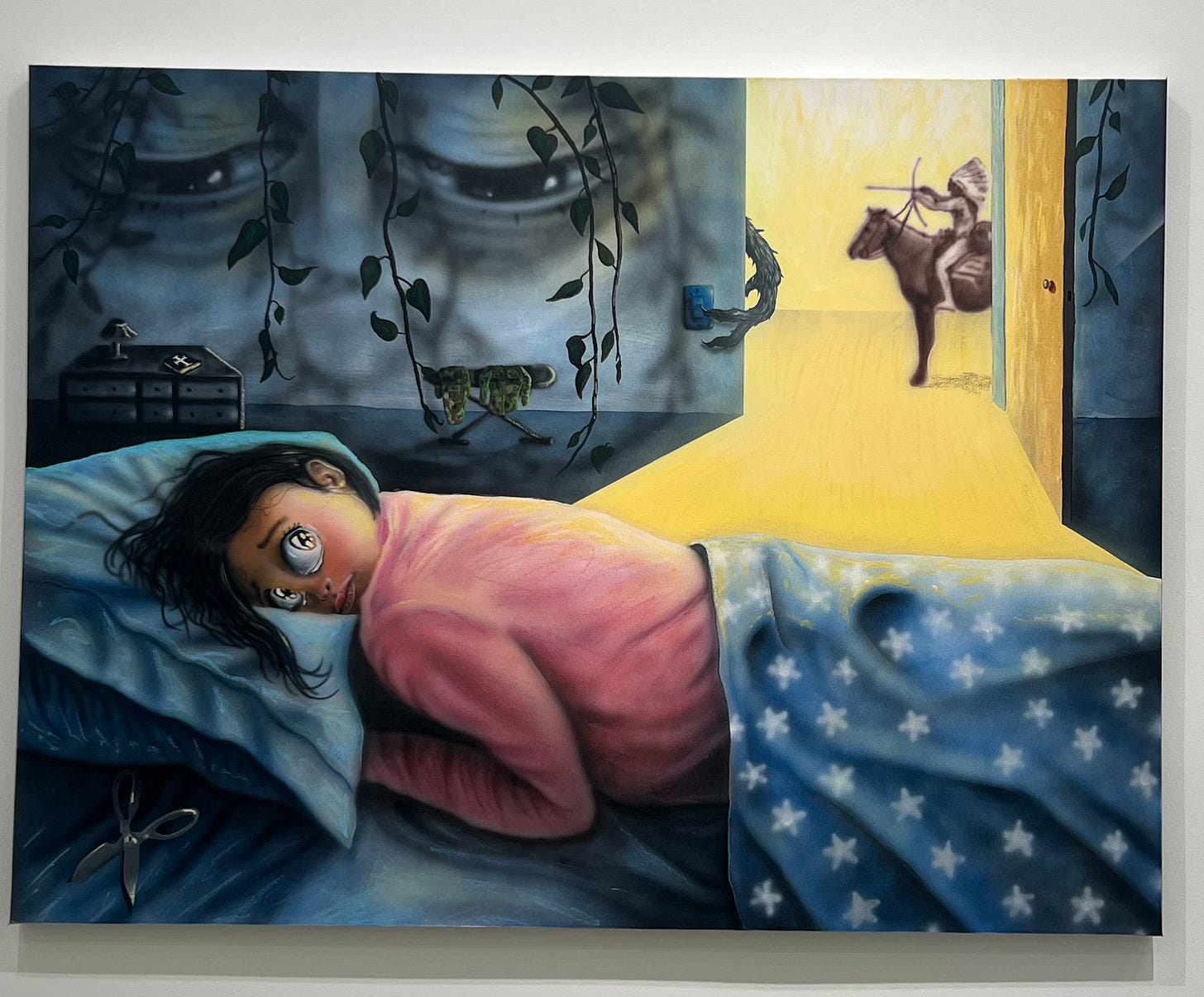I met up with artist Pedro Troncoso outside of Raf’s in NoHo where I was having breakfast with fellow Texan and social media expert turned gallery guru Lauren Ray Youngblood. Lauren and I had been discussing the pendulum swinging back to text after reels have been dominating marketing initiatives and how we might collaborate. Pedro, an artist featured in my dissertation on the influence of exhibition text on contemporary art evaluations, just happens to be one of my favorite emerging artists and a friend I share my soft feelings with. He’ll be showing his work at NADA during Art Basel Miami.
I asked Pedro, who I call Dro, to join me to go see Larissa De Jesús Negrón’s solo show at Anna Zorina Gallery. I thought it was a good fit as he has exhibited with her before and been in another show curated by her partner- the independent art curator from Puerto Rico with his finger on the pulse Antonio Del Valle- Lago. En route Dro asked me about my leg warmers. I told him how my mom always tells me to shave my legs and at times will screenshot photos of me on social media, zoom them in to my flaws, and proceed to tell me to do my nails, shave my body, or brush my hair. I’m still learning how to sit with my mom’s consistent criticism and judgment, so I was taken aback when the first work Larissa began our gallery tour with was the portrait of her mother judging her hairy legs.

In Entiendo Porque No Entiendes, you can almost smell the mother’s disgust and criticism with her daughter’s prickly body. I decided I’m going to take a page from Larissa’s approach in that she can’t change her mother, she has to accept how she was conditioned to be. In the corner of this mother-daughter interaction an image of the artist as a little girl in coletas eating cereal disintegrates. I thought back to being a little girl with dark curly hair who still isn't allowed to wear their hair down in my blonde mother’s kitchen. For my own healing, I kinda needed this work to show me that maybe my mom’s judgment of me and fear of my contamination of her pristine perspective isn’t wholly because she’s just White and I’m also Latina but across all cultures mothers stare into their daughter’s beauty standards.
Staring across the room is Larissa’s grandmother who I kept calling la jefa. De Jesús Negrón did a beautiful job of capturing the strength of her grandmother who helped lead a community church along with the artist’s abuelo- who also was a creative and military man. Dios le bendiga shows a pious business woman whose shoulders are strong, reliable, but still exude an undeniable femininity. In the background we see a poinsettia- a plant primarily associated with Christmas time. This Van Gough inspired work along with the other two paintings on the same wall all allude to Christmas or as in Puerto Rico they call it Nochebuena. To latinos, we all celebrate on Christmas Eve- which also happens to be Larissa’s grandfather’s birthday. We spoke about how in Puerto Rico they celebrate in festivities called Parrandas and I explained La Posada tradition of Mexico. In the works Noche Buena, my personal favorite of the exhibition, and Parranda!, an undeniably perfect painting, the artist draws inspiration from botanical illustrations by Agustin Stahl. I absolutely loved these flower elements which were quite different from the iconography I saw used in Larissa's solo show at Guts Gallery in March which was dominated by water elements.
I would have loved the opportunity to collect one of these works if my budget was there. While it’ll be awhile before I make back my savings after spending so much to pursue a higher education and a new life in London, experiencing art shouldn’t be all about buying and selling. Being able to walk through an exhibition with an artist is truly one of the most pleasurable important experiences one can have. Engagement in the story and understanding the moving parts is what us art historians / scientists / models live for. I am so grateful for Larissa’s time and being able to understand more intimately her family history, her perspective, and ultimately what ties her work together. I love how she included a sculpture of her grandfather’s light changing invention that is also referenced in Cobacha, reminding us all creativity isn't limited to producing a painting but is found in all outlets of living.
Two artworks that really spoke to me as a girl from a big city but small town in Texas were Hablando de ti and No Puedo Dormir Sola. The former references the toxic gossip culture of small towns and how destructive chisme can be. Integrity and kindness are perhaps the two qualities that I look for most in friends and the people I connect with. I think sometimes the artworld can be insidious in that way with layers of cool and who’s who, that is all just based off of telephone of stories shared behind peoples’ backs. It was refreshing to see an artist of Larissa’s caliber to call it out. Curatorially arranged next to the portrait of shark-toothed-pot-stirrers is No Puedo Dormir Sola. This fantastic piece is actually a story of the artist’s aunt about a nightmare she had of a monster turning off the light and an indigenous man on a horse. Her tía, a little girl in bed, with scissors like the cross of a bible under her pillow to ward off evil spirits is wrapped in a star spangled banner blanket.
We talked about the situation in PR and America’s mistreatment of the island. I often feel Texas is also abused by the United States. If you know me, you know I consider myself Texan and reject American. Most of America takes Texas's resources, calls us racist and uneducated when really we are living in a repressive regime that wants us to be the second worst educated state so there will be plenty of workers to provide for the rest of the country. We’re left to freeze during violent weather storms and often ignored when we plead for help to resist these right wingers who seek to frack our beauty and control women’s bodies. Most people forget the lone star state is the second most diverse and has the most Black people. The left also often forgets to advocate for PR.
This solo exhibition at Anna Zorina Gallery features 18 works of mixed media. I have so much respect for the ambition Larissa has to present such a wide range of materials and to execute each with finesse and confidence. Dro and I spent time complimenting the silky smooth La Más Bella, a large-scale work detailing the notable victory of Marisol Malaret as the first Caribbean Miss Universe. Technically speaking the ability to work on linen and still maintain so much light without over saturation is quite the feat. The compact mirrors somehow mimic the mouth to which we all were copying while gawking.
We finished our tour looking at the work Mi Canción Verde, which features the little froggy that the exhibition La Canción Verde derives its title. In this children’s book one of the tiny Coqui people who resemble tree frogs, leaves his home in the green sugar fields of Puerto Rico and travels to New York to witness the vast and ranging colors of the world. Just like Larissa, a NYC resident for 8 years, this exhibition is a testament to all the Puerto Rican artist has absorbed and so kindly shares with her viewers.












